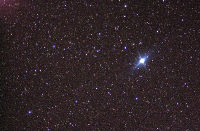Canopus
 From Conservapedia
From Conservapedia | Canopus | |
|---|---|

| |
| Observational Data | |
| Designation | Alpha Carinae |
| Right ascension | 06h 23m 57.1099s |
| Declination | -52o 41′ 44.378″ |
| Constellation | Carina |
| Type of object | Supergiant star |
| Magnitude | Absolute Mag: -0.72 Apparent Mag: -5.53 |
| Astrometry | |
| Distance from Earth | 310 ±20 ly |
| Radial velocity | 20.5 km/s |
| Proper motion | RA: 19.99 mas/yr Dec.: 23.67 mas/yr |
| Parallax | 10.43 ±0.53 mas |
Canopus, also known as Alpha Carinae, is the brightest star in the constellation of Carina. It is also the second brightest star in the night sky, with only Sirius appearing more luminous. The star has an apparent magnitude of -0.72, making it easily visible in even heavily light polluted skies.
Because Canopus is 53 degrees south of the celestial equator, it is not visible in latitudes above 37 degrees north, which includes most of Europe, all of Canada, and half the continental United States. The star itself is a rare example of a F class supergiant.[1]
Canopus in History[edit]
Because of its brightness, Canopus has been known since antiquity and is important to navigation. Before the invention of the magnetic compass, the star served as a southern pole star for navigators in the northern hemisphere far south enough to view the star. The Bedouin of the desert regions around the Levant used the star as one of the two main stars for navigation at night, the other being Polaris.[2] Today Canopus is popular for space navigation, thanks to its brightness and distance from the ecliptic. Several spacecraft use a camera called the "Canopus Star Tracker" to help determine attitude.
The name Canopus itself is a Latin derivative of the Greek name Kanôbos, first recorded in Ptolemy's famous Almagest, or "Great Book".[3] The exact origin of the name though is lost in time, although there are a couple hypotheses to its origin:
- Canopus was once the brightest star of the ancient constellation of Argo, the ship Jason and the Argonauts used to search for the Golden Fleece in Greek mythology. The star itself was named after another ship's pilot.
- From the Egyptian Copic name Kahi Nub, meaning "Golden Earth", possibly because the star appeared more yellowish, thanks to the reddening effect by the atmosphere on the star's light at its position near the horizon.[3]
Other names for the star include Suhali, occasionally used in English, based on the Arabic name for various bright stars, سهيل suhayl. The Chinese referred to the star as 老人星 or Lǎorénxīng, meaning "Star of the Old". In Ancient India, it was known as Agasti or Agastya.[3]
Ths Star[edit]
The true distance of the star was not known until the 1990s, and estimates beforehand varied from 96 light years away to some 1200 light years. The Hipparcos satellite telescope finally established the distance of the star to be around 310 light years away.[1]
Canopus itself is a rare spectral class F0 Ia yellow-white supergiant. The star itself is 13,300 times as bright as our Sun. It is some 71 times the Sun's diameter and some 8 to 9 times our Sun's mass. If it was in the center of our solar system it would extend to within 90 percent of Mercury's orbit. The surface temperature of Canopus is estimated to be 7280 K, typical for a star in the F class. The corona of Canopus however is some ten times as hot as our Sun's corona, and is a considerable source of X-rays.[4]
There are no known substellar companions of Canopus. For an Earth-like world to exist comfortably with liquid water on its surface around Canopus, it would have to be around three times the distance Pluto is from the Sun.
References[edit]
- ↑ 1.0 1.1 http://simbad.u-strasbg.fr/simbad/sim-id?Ident=name+canopus
- ↑ http://www.jstor.org/pss/613801
- ↑ 3.0 3.1 3.2 Allen, Richard Hinckley (1963). Star Names: Their Lore and Meaning (Revised ed.). New York: Dover Publications. pp. 67–72. ISBN 0486210790.
- ↑ http://stars.astro.illinois.edu/sow/canopus.html
Categories: [Astronomy]
↧ Download as ZWI file | Last modified: 02/17/2023 21:05:57 | 9 views
☰ Source: https://www.conservapedia.com/Canopus | License: CC BY-SA 3.0
 ZWI signed:
ZWI signed: KSF
KSF